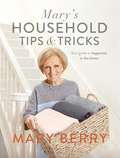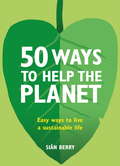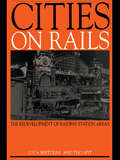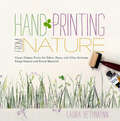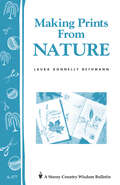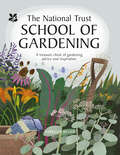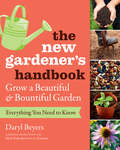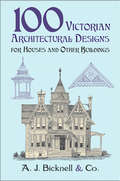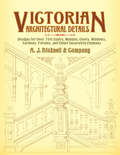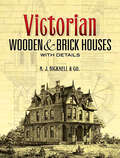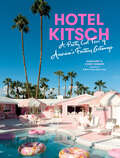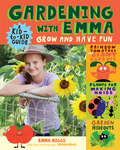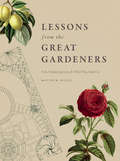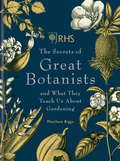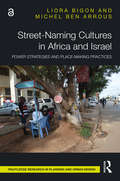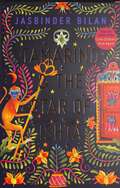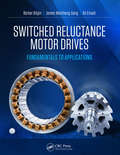- Table View
- List View
House of Fashion: Haute Couture and the Modern Interior
by Jess BerrySince Charles Fredrick Worth established his luxurious Maison de Couture in 1858, the interior has played a crucial role in the display of fashion. House of Fashion provides a full historical account of the interplay between fashion and the modern interior, demonstrating how they continue to function as a site for performing modern, gendered identities for designers and their clientele alike. In doing so, it traces how designers including Poiret, Vionnet, Schiaparelli and Dior used commercial spaces and domestic interiors to enhance their credentials as connoisseurs of taste and style.Taking us from the early years of haute couture to the luxury fashion of the present day, Berry explores how the salon, the atelier and the boutique have allowed fashion to move beyond the aesthetics of dress, to embrace the visual seduction of the theatrical, artistic, and the exotic. From the Art Deco allure of Coco Chanel's Maison to the luminous spaces of contemporary flagship stores, House of Fashion sets out fashion's links with key figures in architecture and design, including Louis Süe, Robert Mallet-Stevens, Eileen Gray, and Jean-Michel Frank. Drawing on photographs, advertisements, paintings and illustrations, this interdisciplinary study examines how fashionable interiors have shaped our understanding of architecture, dress, and elegance.
House of Fashion: Haute Couture and the Modern Interior
by Jess BerrySince Charles Fredrick Worth established his luxurious Maison de Couture in 1858, the interior has played a crucial role in the display of fashion. House of Fashion provides a full historical account of the interplay between fashion and the modern interior, demonstrating how they continue to function as a site for performing modern, gendered identities for designers and their clientele alike. In doing so, it traces how designers including Poiret, Vionnet, Schiaparelli and Dior used commercial spaces and domestic interiors to enhance their credentials as connoisseurs of taste and style.Taking us from the early years of haute couture to the luxury fashion of the present day, Berry explores how the salon, the atelier and the boutique have allowed fashion to move beyond the aesthetics of dress, to embrace the visual seduction of the theatrical, artistic, and the exotic. From the Art Deco allure of Coco Chanel's Maison to the luminous spaces of contemporary flagship stores, House of Fashion sets out fashion's links with key figures in architecture and design, including Louis Süe, Robert Mallet-Stevens, Eileen Gray, and Jean-Michel Frank. Drawing on photographs, advertisements, paintings and illustrations, this interdisciplinary study examines how fashionable interiors have shaped our understanding of architecture, dress, and elegance.
Mary's Household Tips and Tricks: Your Guide to Happiness in the Home
by Mary BerryOne of the Guardian's TOP TEN BOOKS to gift. 'It's practical AND beautiful . . . an ideal gift' Graham Norton, BBC Radio 2Britain's best-loved cook and national treasure Mary Berry lets readers in on her very own household secrets . . . A comprehensive, beautifully illustrated guide that shares her greatest tips on how to care for your home. 'This book is a collection of skills I've learned for running a home. Gleaned from years of practical experience, along with all the hints that friends and family have imparted to me, I hope it will be a helping hand' - Mary BerryInside you'll find . . . A KITCHEN KNOW-HOW for the heart of your home - Freezer tips - Organize your food - CLEANING & CONFIGURING YOUR HOME - Create cleaning products from store cupboard items - LAUNDRY & WARDROBE WISDOM - Banish moths from your home for good - Remove stains from every kind of fabric - get green fingered with GARDENING & FLOWERS - Bring greenery into your home even without a garden - Create beautiful flower arrangements - And finally master the art of HOSTING & ADDING THE EXTRA TOUCHES for sparkling parties at home.Easy to use, practical and gorgeously illustrated, Mary's Household Tips & Tricks covers everything from Mary's golden rules for baking to her favourite flowers for each season, from how to polish silver to whether tea should be poured before or after milk. With secrets for accomplishing the most challenging home-keeping tasks with ease, Mary's wonderfully simple book will help turn any house into a home.'The Queen of British baking has whipped up a recipe for home happiness' The Independent'A domestic goddess' The Daily Telegraph
50 Ways to Help the Planet: Easy ways to live a sustainable life
by Sian BerryWe are becoming increasingly aware and engaged in environmental issues, but it's not always clear what the solutions are and how we can do our bit. We are ready and willing to make changes to our lifestyles, but often the advice about which are the best ones to make can be confusing.In this friendly guide you are shown how you can make changes in a positive and practical manner, and with some suggestions easier than others, there's a multitude of ways in which you can live more sustainably. Siân looks at the choices we can all make, helping you to reduce your carbon footprint and the impact of your lifestyle on the planet and change the world without changing your life.The 50 ways are divided into Plastics, Energy, Cooking and Eating, Travel, In the Garden and Action, and include a range of options, such as buying plastic-free beauty products, upcycling your furniture, cutting down on meat and having greener celebrations.
Cities on Rails: The Redevelopment of Railway Stations and their Surroundings
by Luca Bertolini Tejo SpitThe development of railway stations and their surroundings is an emerging feature in current urban projects. Based on a series of the most inspiring contemporary European examples of station redevelopment, this book will help planners and urban designers understand the specific and complex nature of station locations. Based on their extensive research, the authors, pioneers of studies in the field in the last few years, harness and expand the body of knowledge and present guiding principles and conditions for successful implementation of such planning projects.
Hand Printing from Nature: Create Unique Prints for Fabric, Paper, and Other Surfaces Using Natural and Found Materials
by Laura Donnelly BethmannDiscover how to use natural materials to print on any surface, from paper and fabric to ceramics, wood, and walls. With simple step-by-step instructions and clear photographs, Laura Bethmann encourages crafters of all levels to create original nature prints with leaves, flowers, fruits, shells, stones, and more. Her unique project ideas include stationery printed with maple leaves, a clothes hamper printed with scallop shells, and a pillow printed with cabbage. Before you know it, you&’ll be designing one-of-a-kind nature prints to reflect your unique personality and style.
Making Prints from Nature: Storey's Country Wisdom Bulletin A-177 (Storey Country Wisdom Bulletin)
by Laura Donnelly BethmannSince 1973, Storey's Country Wisdom Bulletins have offered practical, hands-on instructions designed to help readers master dozens of country living skills quickly and easily. There are now more than 170 titles in this series, and their remarkable popularity reflects the common desire of country and city dwellers alike to cultivate personal independence in everyday life.
National Trust School of Gardening
by Rebecca Bevan National Trust BooksElevate your own green space and become a more confident and creative gardener with lessons from experienced National Trust gardeners in this comprehensive horticultural guide.
The New Gardener's Handbook: Everything You Need to Know to Grow a Beautiful and Bountiful Garden
by Daryl BeyersFrom one of the experts at the New York Botanical Garden, this guide shares the science of good gardening in a design-forward, beginner-friendly way that will appeal to new gardeners everywhere.
The Emerging Asian City: Concomitant Urbanities & Urbanisms
by Vinayak BharneThe Asian urban landscape contains nearly half of the planet’s inhabitants and more than half of its slum population living in some of its oldest and densest cities. It encompasses some of the world’s oldest civilizations and colonizations, and today contains some of the world’s fastest growing cities and economies. As such Asian cities create concomitant imagery – polarizations of poverty and wealth, blurred lines between formality and informality, and stark juxtapositions of ancient historic places with shimmering new skylines. This book embraces the complexity and ambiguity of the Asian urban landscape, and surveys its bewildering array of multifarious urbanities and urbanisms. Twenty-four essays offer scholarly reflections and positions on the complex forces and issues shaping Asian cities today, looking at why Asian cities are different from the West and whether they are treading a different path to their futures. Their combined narrative – spanning from Turkey to Japan and Mongolia to Indonesia - is framed around three sections: Traditions reflects on indigenous urbanisms and historic places, Tensions reflects on the legacies of Asia’s East–West dialectic through both colonialism and modernism and Transformations examines Asia’s new emerging utopias and urban aspirations. The book claims that the histories and destinies of cities across various parts of Asia are far too enmeshed to unpack or oversimplify. Avoiding the categorization of Asian cities exclusively by geographic location (south-east, Middle East), or the convenient tagging of the term Asian on selective regional parts of the continent, it takes a broad intellectual view of the Asian urban landscape as a 'both…and' phenomenon; as a series of diverse confluences – geographic, historic and political – extending from the deserts of the Persian Gulf region to the Pearl River Delta. Arguing for Asian cities to be taken seriously on their own terms, this book represents Asia – as a fount of extraordinary knowledge that can challenge our fundamental preconceptions of what cities are and ought to be.
The Emerging Asian City: Concomitant Urbanities & Urbanisms
by Vinayak BharneThe Asian urban landscape contains nearly half of the planet’s inhabitants and more than half of its slum population living in some of its oldest and densest cities. It encompasses some of the world’s oldest civilizations and colonizations, and today contains some of the world’s fastest growing cities and economies. As such Asian cities create concomitant imagery – polarizations of poverty and wealth, blurred lines between formality and informality, and stark juxtapositions of ancient historic places with shimmering new skylines. This book embraces the complexity and ambiguity of the Asian urban landscape, and surveys its bewildering array of multifarious urbanities and urbanisms. Twenty-four essays offer scholarly reflections and positions on the complex forces and issues shaping Asian cities today, looking at why Asian cities are different from the West and whether they are treading a different path to their futures. Their combined narrative – spanning from Turkey to Japan and Mongolia to Indonesia - is framed around three sections: Traditions reflects on indigenous urbanisms and historic places, Tensions reflects on the legacies of Asia’s East–West dialectic through both colonialism and modernism and Transformations examines Asia’s new emerging utopias and urban aspirations. The book claims that the histories and destinies of cities across various parts of Asia are far too enmeshed to unpack or oversimplify. Avoiding the categorization of Asian cities exclusively by geographic location (south-east, Middle East), or the convenient tagging of the term Asian on selective regional parts of the continent, it takes a broad intellectual view of the Asian urban landscape as a 'both…and' phenomenon; as a series of diverse confluences – geographic, historic and political – extending from the deserts of the Persian Gulf region to the Pearl River Delta. Arguing for Asian cities to be taken seriously on their own terms, this book represents Asia – as a fount of extraordinary knowledge that can challenge our fundamental preconceptions of what cities are and ought to be.
100 Victorian Architectural Designs for Houses and Other Buildings (Dover Architecture)
by A. J. Bicknell Co.Originally published in 1878, this now-rare collection of designs supplies views of a remarkable variety of modestly priced structures: houses, villas, cottages, many others. Handsome drawings of perspective views and elevations, some of which include floor plans, plus suggestions for interior design. 98 black-and-white illustrations.
Victorian Architectural Details: Designs for Over 700 Stairs, Mantels, Doors, Windows, Cornices, Porches, and Other Decorative Elements
by A. J. Bicknell Co.Hundreds of rare illustrations depict wide range of design alternatives for prospective homeowners and other customers of the late 19th century. While the collection includes elevations and floor plans for a variety of handsome, private residences and commercial structures, the emphasis is on architectural details — from dormer windows to balconies.
Victorian Wooden and Brick Houses with Details
by A. J. Bicknell Co.This vintage volume offers a treasure trove of floor plans, elevations, and details of residences and public buildings. Artists, architects, and historians alike will find it an endless source of inspiration.Featured buildings include villas, cottages, and farm houses as well as churches, schools, banks, and many other structures. Eighty-one remarkably detailed illustrations capture the elaborate, distinctive beauty of Victorian-era cornices, staircases, gables, verandas, doors, dormers, and other architectural elements. In addition, a fascinating "Specifications" section highlights construction guidelines for masons, bricklayers, and carpenters.
Introduction to Residential Layout
by Mike BiddulphIntroduction to Residential Layout is ideal for students and practitioners of urban design, planning, engineering, architecture and landscape seeking a comprehensive guide to the theory and practice of designing and laying out residential areas.Mike Biddulph provides a clear and coherent framework from which he offers comprehensive practical advice for designers of housing developments. Referring to a wealth of international examples, this is a richly illustrated, accessible resource covering the whole range of issues that should be considered byanyone engaging in the planning and design of a new residential scheme.A successful residential development must work on many levels – financial, social and environmental. This book includes analysis of commercial viability, the importance of place making, environmental sustainability and designing accessibility. Mike Biddulph details successful approaches to designing out crime and maximising permeability as part of an integrated approach to urban design.Highly illustrated throughout, this work will show you how to turn design aspirations and principles into practical design solutions. Written without preconceptions, Introduction to Residential Designhighlights the strengths and weaknesses of particular design solutions to encourage both depth of thought and creativity.Mike Biddulph is Senior Lecturer in Urban Design at Cardiff University
Introduction to Residential Layout
by Mike BiddulphIntroduction to Residential Layout is ideal for students and practitioners of urban design, planning, engineering, architecture and landscape seeking a comprehensive guide to the theory and practice of designing and laying out residential areas.Mike Biddulph provides a clear and coherent framework from which he offers comprehensive practical advice for designers of housing developments. Referring to a wealth of international examples, this is a richly illustrated, accessible resource covering the whole range of issues that should be considered byanyone engaging in the planning and design of a new residential scheme.A successful residential development must work on many levels – financial, social and environmental. This book includes analysis of commercial viability, the importance of place making, environmental sustainability and designing accessibility. Mike Biddulph details successful approaches to designing out crime and maximising permeability as part of an integrated approach to urban design.Highly illustrated throughout, this work will show you how to turn design aspirations and principles into practical design solutions. Written without preconceptions, Introduction to Residential Designhighlights the strengths and weaknesses of particular design solutions to encourage both depth of thought and creativity.Mike Biddulph is Senior Lecturer in Urban Design at Cardiff University
Hotel Kitsch: A Pretty Cool Tour of America's Fantasy Getaways
by Margaret Bienert Corey BienertA visual celebration of the best fantasy suites and honeymoon hotels across America and beyond, from the creators of A Pretty Cool Hotel Tour In 1963, the savvy owners of the Cove Haven Resort in the Poconos unveiled their heart-shaped tub. Like Elvis Presley and Playboy magazine, it launched a postwar phenomenon that defined a new era of pop pleasure: the honeymoon hotel. Destinations across the country were soon racing to catch up, installing not just heart-shaped tubs but all types of over-the-top design flourishes, from pink shag carpeting to immersive worlds worthy of a Broadway stage set, in order to create a sense of romance, fantasy, even adventure. From the photographers and inveterate travelers behind the social media sensation A Pretty Cool Hotel Tour, Hotel Kitsch celebrates dozens of creative, nostalgic, one-of-a-kind hotels that span the heart of the Poconos and across the United States to Mexico, Spain, and the UK. Discover, in the middle of Iowa, a jungle room with fake trees and foliage surrounding the bed as if it had taken its cue from Where the Wild Things Are. Or Jules&’ Undersea Lodge in Key Largo where the rooms are reached by scuba diving. An Arctic Cave room at a hotel in Kentucky with its carved blue walls and not a window to be found. And on the California coast, the iconic Madonna Inn featuring 110 rooms, each themed and no two alike. Along the way, authors Margaret and Corey Bienert uncover too many wild details to mention, including unconventional beds (a Cadillac, a clamshell, a sandwich), mirrors on mirrors on mirrors, in-room swimming pools, full suits of armor, and fiber-optic star ceilings. While it&’s not a travel guide, every destination in Hotel Kitsch is open for business. Time to check in.
Gardening with Emma: Grow and Have Fun: A Kid-to-Kid Guide
by Emma Biggs Steven BiggsEmma Biggs, an enthusiastic 13-year-old with a love of gardening, shares her just-for-kids advice on growing a food garden, including theme garden ideas and tips for preparing, planting, and caring for a garden, along with creative ways to have fun doing it.
Lessons from the Great Gardeners: Forty Gardening Icons and What They Teach Us
by Matthew BiggsLike heirloom seeds and grafts from trees, advice from great gardeners handed down through the centuries has shaped the science and art of gardens across the globe. Spanning gardeners from fifteenth-century Japan to the contemporary United States, Lessons from the Great Gardeners profiles forty groundbreaking botanists, nurserymen, and tillers of earth, men and women whose passion, innovation, and green thumbs endure in the formal landscapes and vegetable patches of today. Entries for each gardening great highlight their iconic plants and garden designs, revealing both the gardeners’ own influences and the seeds—sometimes literal—that they sowed for gardens yet to sprout. From André Le Nôtre in seventeenth-century France, who drew on his training as an architect and hydraulic engineer to bring the topiary form to Vaux-le-Vicomte and Versailles, to the work of High Line and Lurie Garden designer Piet Oudolf, and Thomas Jefferson’s advice on creating protected garden microclimates for help growing early crops and tender fruit like figs (with peas, a Jefferson favorite), Lessons from the Great Gardeners is a resource as rich as the soil from which it springs. Featuring lush illustrations harvested from the archives of the Royal Horticultural Society, as well as sections on a dozen international gardens that showcase the lessons of the greats, this homage to the love of good, clean dirt is sure to inspire readers to get out in the sun and dig.
Lessons from the Great Gardeners: Forty Gardening Icons and What They Teach Us
by Matthew BiggsLike heirloom seeds and grafts from trees, advice from great gardeners handed down through the centuries has shaped the science and art of gardens across the globe. Spanning gardeners from fifteenth-century Japan to the contemporary United States, Lessons from the Great Gardeners profiles forty groundbreaking botanists, nurserymen, and tillers of earth, men and women whose passion, innovation, and green thumbs endure in the formal landscapes and vegetable patches of today. Entries for each gardening great highlight their iconic plants and garden designs, revealing both the gardeners’ own influences and the seeds—sometimes literal—that they sowed for gardens yet to sprout. From André Le Nôtre in seventeenth-century France, who drew on his training as an architect and hydraulic engineer to bring the topiary form to Vaux-le-Vicomte and Versailles, to the work of High Line and Lurie Garden designer Piet Oudolf, and Thomas Jefferson’s advice on creating protected garden microclimates for help growing early crops and tender fruit like figs (with peas, a Jefferson favorite), Lessons from the Great Gardeners is a resource as rich as the soil from which it springs. Featuring lush illustrations harvested from the archives of the Royal Horticultural Society, as well as sections on a dozen international gardens that showcase the lessons of the greats, this homage to the love of good, clean dirt is sure to inspire readers to get out in the sun and dig.
RHS The Secrets of Great Botanists: and What They Teach Us About Gardening
by Matthew BiggsBotanists are the trailblazers who first discovered how plants work and collected from around the world many of the species that we find in our gardens today. This informative and beautiful guide presents the stories of 35 plant collectors and gardening pioneers of the past and present, including Joseph Banks, Asa Gray and Marianne North.Arranged in chronological order, each profile covers one botanist, presenting their life story, discoveries and legacy, while special feature pages reveal their secrets, exploring the qualities that brought them success and showing what ordinary gardeners can learn from them.Illustrated with beautiful period botanical watercolours and vibrant photographs, RHS The Secrets of Great Botanists will provide inspiration and practical guidance for gardeners of all levels, from successful plant cultivation to adding interest to your garden.
Street-Naming Cultures in Africa and Israel: Power Strategies and Place-Making Practices
by Liora Bigon Michel Ben ArrousThis book is focused on the street-naming politics, policies and practices that have been shaping and reshaping the semantic, textual and visual environments of urban Africa and Israel. Its chapters expand on prominent issues, such as the importance of extra-formal processes, naming reception and unofficial toponymies, naming decolonisation, place attachment, place- making and the materiality of street signage. By this, the book directly contributes to the mainstreaming of Africa’s toponymic cultures in recent critical place-names studies. Unconventionally and experimentally, comparative glimpses are made throughout between toponymic experiences of African and Israeli cities, exploring pioneering issues in the overwhelmingly Eurocentric research tradition. The latter tends to be concentrated on Europe and North America, to focus on nationalistic ideologies and regime change and to over-rely on top-down ‘mere’ mapping and street indexing. This volume is also unique in incorporating a rich and stimulating variety of visual evidence from a wide range of African and Israeli cities. The materiality of street signage signifies the profound and powerful connections between structured politics, current mundane practices, historical traditions and subaltern cultures. Street-Naming Cultures in Africa and Israel is an important contribution to urban studies, toponymic research and African studies for scholars and students.
Street-Naming Cultures in Africa and Israel: Power Strategies and Place-Making Practices
by Liora Bigon Michel Ben ArrousThis book is focused on the street-naming politics, policies and practices that have been shaping and reshaping the semantic, textual and visual environments of urban Africa and Israel. Its chapters expand on prominent issues, such as the importance of extra-formal processes, naming reception and unofficial toponymies, naming decolonisation, place attachment, place- making and the materiality of street signage. By this, the book directly contributes to the mainstreaming of Africa’s toponymic cultures in recent critical place-names studies. Unconventionally and experimentally, comparative glimpses are made throughout between toponymic experiences of African and Israeli cities, exploring pioneering issues in the overwhelmingly Eurocentric research tradition. The latter tends to be concentrated on Europe and North America, to focus on nationalistic ideologies and regime change and to over-rely on top-down ‘mere’ mapping and street indexing. This volume is also unique in incorporating a rich and stimulating variety of visual evidence from a wide range of African and Israeli cities. The materiality of street signage signifies the profound and powerful connections between structured politics, current mundane practices, historical traditions and subaltern cultures. Street-Naming Cultures in Africa and Israel is an important contribution to urban studies, toponymic research and African studies for scholars and students.
Tamarind & the Star of Ishta (PDF)
by Jasbinder BilanFrom the author of the Costa Award-winning Asha & the Spirit Bird comes a breathtaking, magical adventure ... WINNER OF THE INDIE CHILDREN'S BOOK AWARD LONGLISTED FOR THE BLUE PETER BOOK AWARD 'I absolutely adored it ... an achingly beautiful story' Sita Brahmachari 'A lush, gorgeous setting in a novel as vivid and original as her Costa-winning debut.' The Guardian 'Beautifully written, richly atmospheric and touchingly spiritual, this brief novel sparkles like a polished gem' Daily Mail Tamarind never knew her Indian mum, who died soon after she was born. So when she arrives at her ancestral home, a huge mansion in the Himalayas surrounded by luxuriant gardens, she's full of questions for her extended family. But instead of answers, she finds an ominous silence - and a trickle of intriguing clues: an abandoned hut, a friendly monkey, a glowing star ring, and a strange girl in the garden who calls herself Ishta.
Switched Reluctance Motor Drives: Fundamentals to Applications
by Berker Bilgin James Weisheng Jiang Ali EmadiElectric motors are the largest consumer of electric energy and they play a critical role in the growing market for electrification. Due to their simple construction, switched reluctance motors (SRMs) are exceptionally attractive for the industry to respond to the increasing demand for high-efficiency, high-performance, and low-cost electric motors with a more secure supply chain. Switched Reluctance Motor Drives: Fundamentals to Applications is a comprehensive textbook covering the major aspects of switched reluctance motor drives. It provides an overview of the use of electric motors in the industrial, residential, commercial, and transportation sectors. It explains the theory behind the operation of switched reluctance motors and provides models to analyze them. The book extensively concentrates on the fundamentals and applications of SRM design and covers various design details, such as materials, mechanical construction, and controls. Acoustic noise and vibration is the most well-known issue in switched reluctance motors, but this can be reduced significantly through a multidisciplinary approach. These methodologies are explained in two chapters of the book. The first covers the fundamentals of acoustic noise and vibration so readers have the necessary tools to analyze the problems and explains the surface waves, spring-mass models, forcing harmonics, and mode shapes that are utilized in modeling and analyzing acoustic noise and vibration. The second applies these fundamentals to switched reluctance motors and provides examples for determining the sources of any acoustic noise in switched reluctance motors. In the final chapter two SRM designs are presented and proposed as replacements for permanent magnet machines in a residential HVAC application and a hybrid-electric propulsion application. It also shows a high-power and compact converter design for SRM drives. Features: Comprehensive coverage of switched reluctance motor drives from fundamental principles to design, operation, and applications A specific chapter on electric motor usage in industrial, residential, commercial, and transportation applications to address the benefits of switched reluctance machines Two chapters address acoustic noise and vibration in detail Numerous illustrations and practical examples on the design, modeling, and analysis of switched reluctance motor drives Examples of switched reluctance motor and drive design


